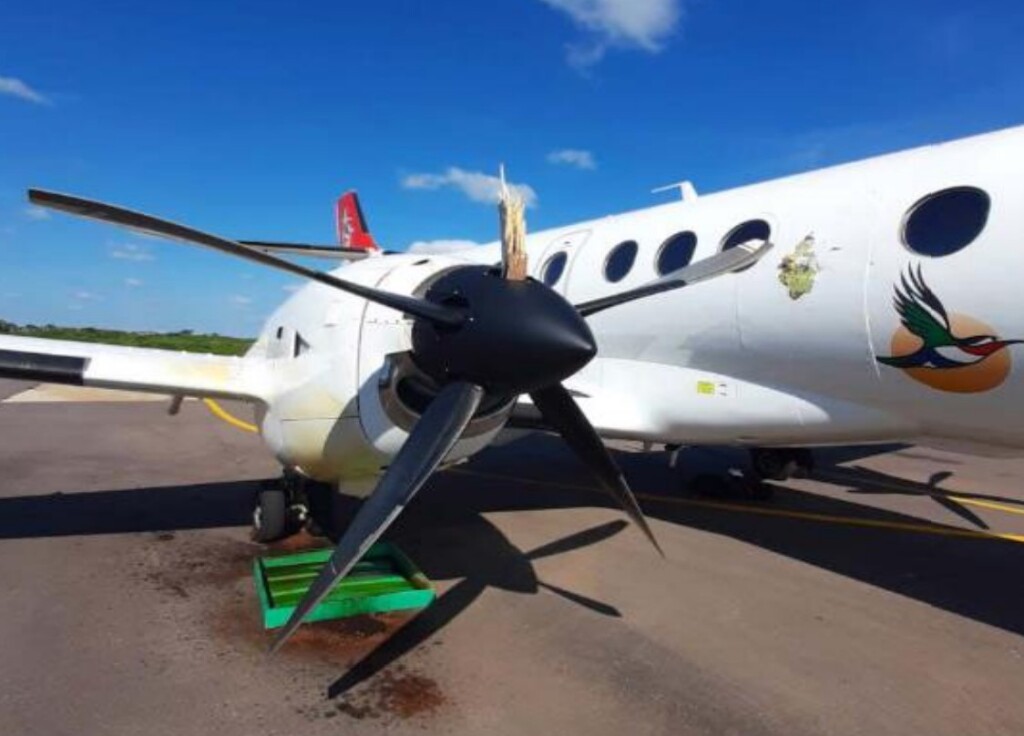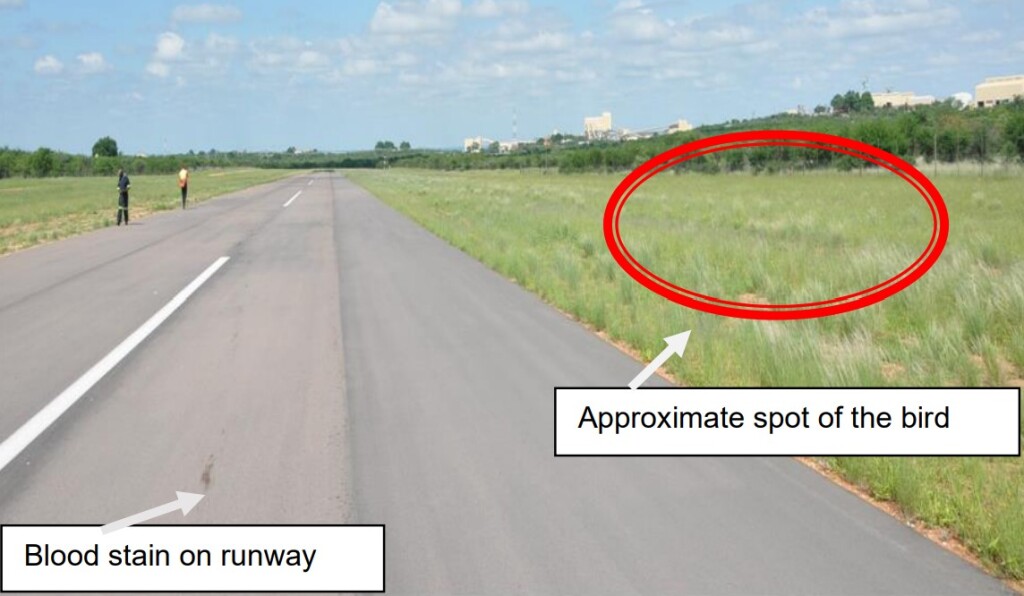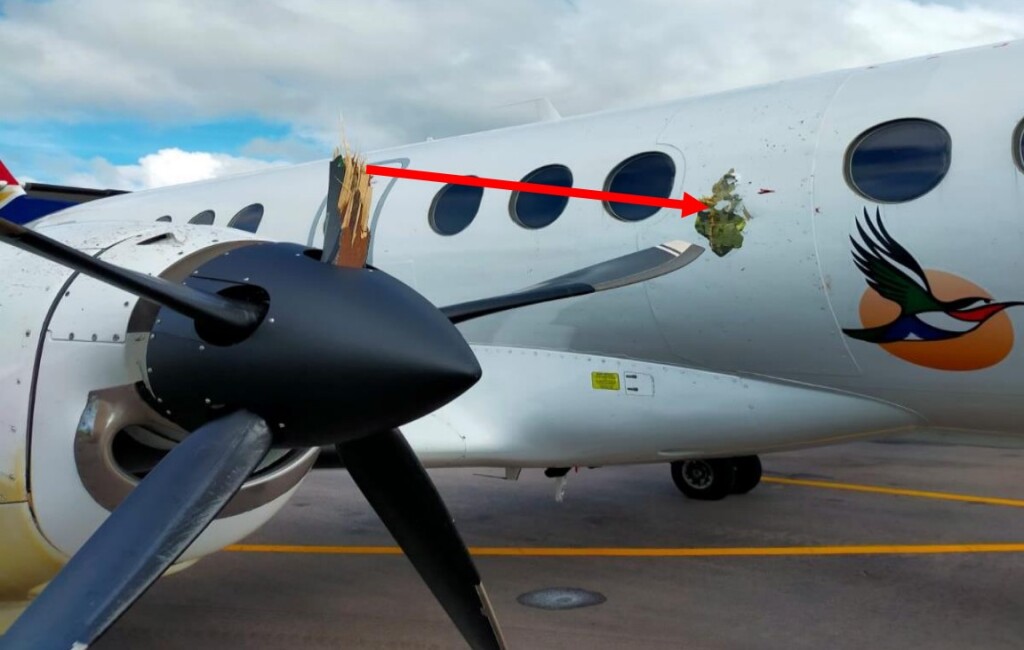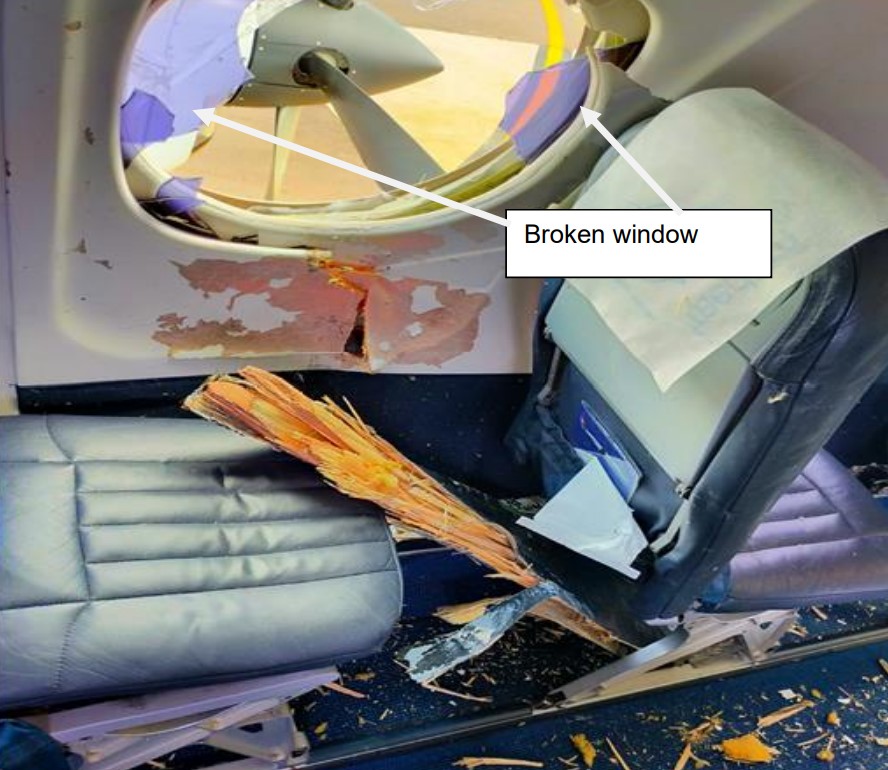Big Bustard Busts Blade: Propeller Blade Failure After Bird Strike (Airlink J41 ZS-NRJ vs a Kori Bustard, Venetia Mine, South Africa)
On 3 January 2022, BAE Jetstream 41 ZS-NRJ of Airlink suffered a bird strike and propeller blade loss after touchdown at Venetia Mine Aerodrome (FAVM), Limpopo Province, South Africa. The propeller blade entered the cabin but fortuitously on this low load factor flight (there were only 4 passengers) none of the occupants were injured.
The South African Civil Aviation Authority (SA CAA) Accident and Incident Investigations Division has issued their Preliminary Report:
FAVM is an unmanned, licensed aerodrome; it has one runway [1538 x 15 m] oriented 08/26.
Approximately 15 nautical miles (nm) to FAVM during descent, the first officer (FO) made a radio call to FAVM inspector…to inform him that they will be landing shortly. Thereafter, the aerodrome inspector went to performed runway inspection in preparation for the aircraft to land. After he had completed inspection, he called the crew and informed them that all was clear.
The crew stated that touchdown was normal on Runway 08 [at c08:10 Local Time], however, during the landing roll at a ground speed of approximately 104.6 knots with the propellers in the reverse thrust configuration (course pitch), a large bird got airborne from the grass area next to the runway on the right side.
The bird impacted the right-side propeller and one of the blades was severed.
The aircraft was fitted with EASA certified MT Propeller MTV-27-1-NCFR(G)J/CFRL-285-82 propellers, whose installation on the J41 was certified under a local Supplemental Type Certificate (STC) to replace the original propeller. These propellers are made from ‘natural composite’ (i.e. laminated compressed wood).
Blade debris penetrated the fuselage at the third row of passenger seats.
Some debris exited through the left hand side cabin window.
The out of balance force damaged the engine mounts and propeller gearbox.
According to the crew, the bird strike caused the aircraft to shake and the number 2 engine to show over temperature indication. The Exhaust Gas Temperature (EGT) indication was over 750°C. The crew followed the engine shut down procedure while bringing the aircraft to a stop on the runway.
The SA CAA say that the accident was “considered survivable”, though this appears to be simply because row 3 was unoccupied. In fact…
The cabin crew member reported that the passenger who was seated in row 3 for weight and balance purposes, vacated the seat during flight to occupy one of the empty seats at the back of the aircraft.
The bird was identified as a Kori Bustard. This species is described as:
…. They live in grasslands and savannas in eastern and southern Africa.
Male kori bustards range in weight from 24-42 pounds (11-19 kilograms), and females are roughly half the size of the males. They stand about 5 feet (1.5 meters) tall.
Kori bustards are omnivorous birds… Insects form a large portion of their diet, especially when they are chicks. They also eat a variety of small mammals, lizards, snakes, seeds and berries. They have been observed eating carrion.
The Kori Bustard far exceeds the size of bird that aircraft, engines and propellers are designed to withstand (19 kg is an order of magnitude greater than the maximum mass for propeller certification). Hence, airfield bird control measures are critical. The SA CAA publish this extract from the Aerodrome Operations Manual:
UPDATE 6 February 2023: SA CAA Final Report Issued
The SCAA has issued their final report. They explain that:
The bird, which was approximately 18kg (40lb), exceeded the certification envelope of the aircraft and propeller by at least factor five; the aircraft was able to withstand a force of up to approximately 3.6kg (8lb).
According to the manufacturer’s report, the extremely low collision speed with a slow-moving bird in combination with the low propeller speed and reverse blade angle is unusual, and the resulting unfavourable impact angle contributed to the extent of damage on the propeller.
They also note that:
The airfield is run by one person who attends to all the requirements of the crew as well as the tasks required before taking off and during landings. This makes it hard to properly monitor and deter wildlife that may enter the runway during the landing and take-off phases of aircraft under normal operations.
The Probable Cause was: A bird strike on the propeller blade caused the overload fracture and separation failure of the blade.
Contributory Factors
3.4.1. Inadequate control of wildlife at the airfield.
3.4.2. Inadequate number of trained personnel to monitor and deter possible wildlife during aircraft operations.
Safety Recommendations
4.2.1. The accident could have been avoided had there been adequate personnel to monitor and deter birds foraging in the grass next to the runway. Thus, it is recommended that there should be an addition of adequately trained staff during aircraft operations to monitor wildlife and aircraft operations.
4.2.2. It is also recommended that a mock runway (a cleared patch covered with grass) be prepared for birds to fly to when chased from the active runway while there are aircraft operations.
Its not immediately clear why having MORE cleared area would not just attract MORE birds.
Safety Resources
You may also find these Aerossurance articles of interest:
- Power of Prediction: Foresight and Flocking Birds looks at how a double engine loss due to striking Canada Geese had been predicted 8 years before the US Airways Flight 1549 ditching in the Hudson.
- Final Report Issued on 2008 B737 Bird Strike Accident in Rome
- NTSB Recommendations on JT15D Failure to Meet Certification Bird Strike Requirements
- USAF T-38C Downed by Bird Strike
- Safety Lessons from a Fatal Helicopter Bird Strike
- USAF HH-60G Downed by Geese in Norfolk, 7 January 2014
- Deadly Dusk Air Ambulance Bird Strike
- Swedish Military NOE Helicopter Bird Strike
Aerossurance is delighted to sponsor the European Society of Air Safety Investigators (ESASI) Regional Seminar 2022 in Budapest, Hungary 6-7 April 2022.











Recent Comments